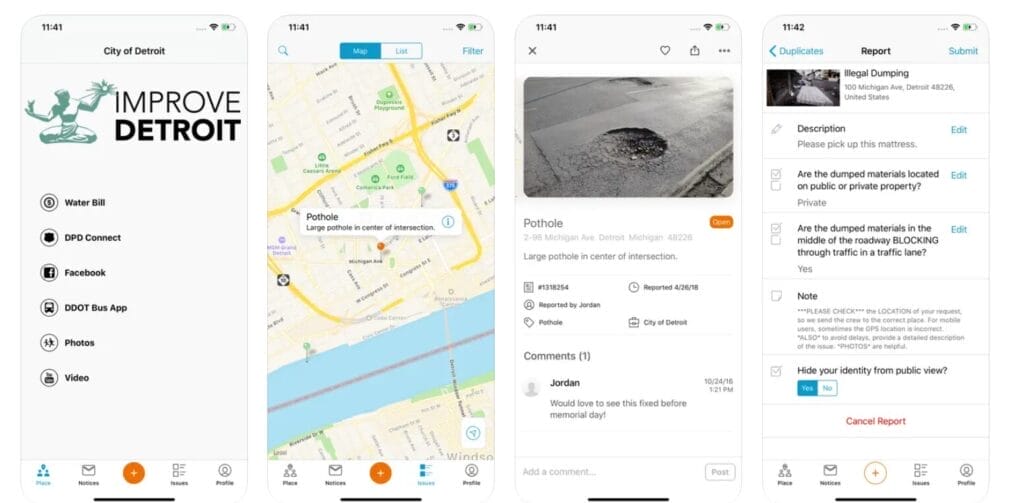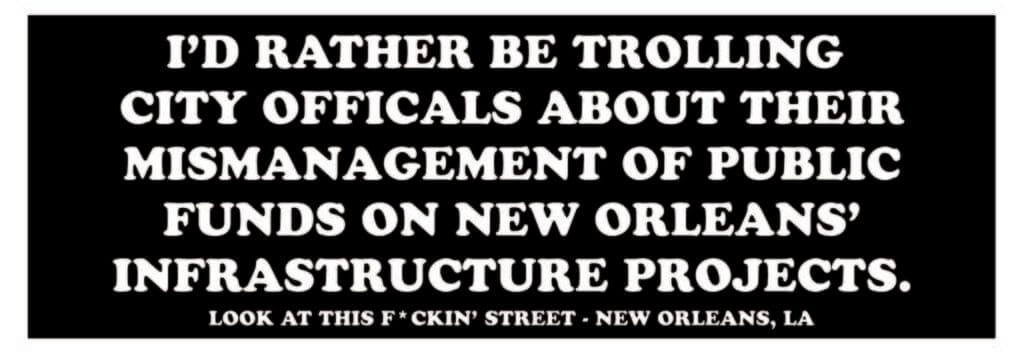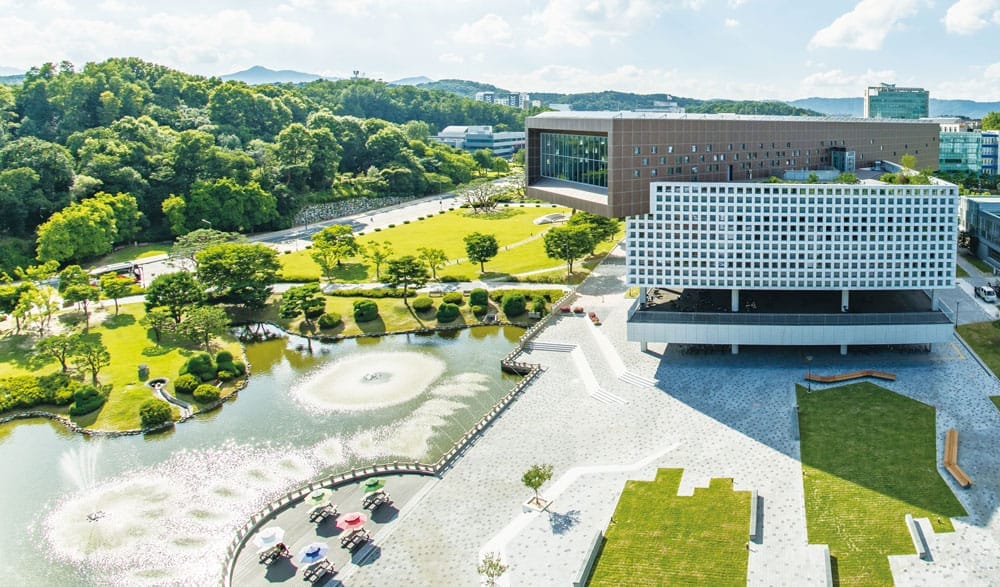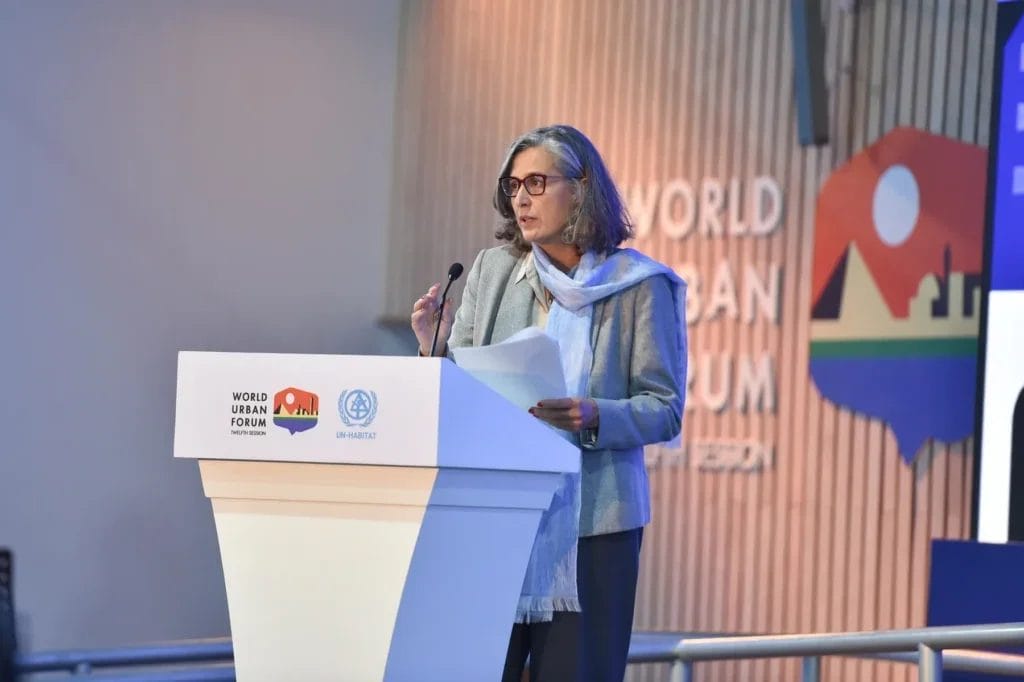Durante años, cierto residente de Nueva Orleans, alguien que conduce mucho por trabajo, se encontraba con algo demasiado conocido cada vez que doblaba en una esquina: calles llenas de baches y pavimentos rotos. “Mira esta maldita calle”, se decía a sí mismo. En realidad, usaba palabras más fuertes que “maldita”. Y un tiempo después, convirtió esta frase en el nombre de usuario de una cuenta de Instagram dedicada a documentar y hablar de los muchos defectos de la infraestructura de Crescent City.
Hoy en día, la cuenta, a la que llamaremos LATFS (lookatthisfuckinstreet) por su sigla en inglés, tiene más de 125.000 seguidores, incluidos empleados de agencias de la ciudad y empresas de agua cuyas cuentas etiquetó en algunas publicaciones sarcásticas. “Pensé que me bloquearían”, dijo el creador de la cuenta, que ha optado por permanecer en el anonimato. En cambio, esas agencias comenzaron a prestar atención a la cuenta y, en algunos casos, los problemas señalados (y ridiculizados) en LATFS se solucionaron con rapidez. Hoy en día, el creador de la cuenta selecciona el contenido que le envían y, si bien la cuenta no forma parte del sistema de mantenimiento de infraestructura de Nueva Orleans de manera oficial, no se puede negar que está presente. Y puede servir como ejemplo para las ciudades que quieren aprovechar los aportes de los ciudadanos para administrar el mantenimiento de la infraestructura.
El uso de la tecnología para fortalecer la comunicación entre el gobierno y los ciudadanos es, por supuesto, una práctica establecida desde hace mucho tiempo. En 1996, la Comisión Federal de Comunicaciones designó el número 311 para llamadas sobre servicios gubernamentales que no sean de emergencia. Baltimore fue la primera ciudad en implementar el sistema 311 ese año y, luego, otras ciudades hicieron lo mismo, de modo que comenzaron a ofrecer una manera fácil de informar sobre baches, grafitis, semáforos que funcionan mal y otras cuestiones. Esta primera versión de colaboración abierta pronto se trasladó a la virtualidad y evolucionó hasta convertirse en sistemas basados en la web o apps que pueden (según el municipio) responder a textos, aceptar fotos o videos e incorporar software de back-end que recopilan y consolidan datos de servicio.
Además, surgieron servicios del sector privado para proporcionar a las ciudades plataformas de conexión ciudadana más fáciles de usar y eficientes. SeeClickFix, pionera en esa categoría, se creó en 2007 y fue adquirida en 2019 por CivicPlus, una firma tecnológica del sector público con más de 10.000 clientes municipales. CivicPlus ofrece varios servicios, desde software y sitios web para gobiernos locales hasta un sistema de alerta de emergencia. Una de las principales prioridades de sus clientes es hacer que estos sistemas funcionen juntos de la mejor manera posible, dice Cari Tate, directora de soluciones de CivicPlus.
Para los productos relacionados con el sistema 311, eso significa hacer que las inquietudes de los usuarios lleguen a la parte correcta del gobierno municipal sin problemas y asegurarse de que las personas se sientan escuchadas. “En el fondo, los residentes quieren que sus comunidades mejoren”, dice Tate, una veterana de SeeClickFix que se unió a CivicPlus luego de la adquisición, “y quieren asociarse con el gobierno local para que eso suceda. Pero, a menudo, no saben cómo hacerlo o sienten que sus comentarios no llegan a buen puerto”.
En parte, se trata de mejorar la funcionalidad. La revista Government Technology publicó un artículo en el que se analizaron los comentarios en la tienda de apps de 75 apps del sistema 311 de distintas ciudades y condados, y se identificó a Improve Detroit como una de las más elogiadas. La app, que utiliza el software SeeClickFix, se actualiza con regularidad para añadir nuevas funciones útiles. Por ejemplo, después de las inundaciones de 2021, el gobierno añadió una herramienta para presentar reclamos por daños causados por el agua.

Pero para que la tecnología conecte de manera efectiva a la ciudadanía con el gobierno, también es clave estar donde están las personas, y eso hoy en día es, cada vez más, en las redes sociales. Durante años, algunos municipios han publicado hashtags, como “#502pothole” (#502baches) en Louisville, que los ciudadanos podían usar para informar problemas.
Pero los usuarios de las redes sociales no necesitan una invitación para hablar sobre las fallas o imperfecciones de la infraestructura local. Y hablar sobre fallas en espacios digitales públicos a menudo se siente más satisfactorio que hacerlo en los canales oficiales. Nueva Orleans, por ejemplo, tiene una línea 311, pero a veces pareciera como una “caja negra” en comparación con la animada camaradería de Instagram, señala el creador de LATFS. Y cuando se obtienen resultados reales a través de Instagram, la atención aumenta. Un ejemplo de esto podría ser la serie de imágenes de una señal de alto caída y su reemplazo pintado a mano por los ciudadanos, que llamó la atención de un concejal de la ciudad que usó los servicios municipales para hacer una verdadera reparación y le dio crédito a LATFS en los medios locales. (Un vocero de la empresa de servicios públicos de alcantarillado y agua de la ciudad dijo que la empresa no “sigue de forma activa” a LATFS, pero conoce la cuenta y que, a menudo, la empresa de servicios públicos se entera de los problemas antes de que aparezcan en las redes sociales, haciendo referencia al número telefónico de contacto oficial que funciona en forma eficaz como la mejor vía para informar sobre los problemas).
Un desafío que enfrenta el uso práctico de las redes sociales es que las reacciones a los problemas transitorios pueden carecer de contexto. Para la planificación de la infraestructura, los datos de las redes sociales son, “en realidad, muy turbios y nada específicos”, dice Julia Kumari Drapkin, directora ejecutiva y fundadora de ISeeChange, una plataforma de datos sobre riesgos climáticos y participación comunitaria que trabaja con Nueva Orleans, Miami y otros municipios y empresas de servicios públicos. Su enfoque toma datos de las redes sociales y utiliza la IA para ayudar a crear soluciones más amplias. Da la casualidad de que ha trabajado con LATFS, ya que le solicitó que dirija a sus seguidores a la app ISeeChange durante la inundación, para que los residentes puedan cargar informes y fotos en tiempo real.
El software de ISeeChange puede combinar esa información con los datos de los clientes y “brindar información a las ciudades, las empresas de servicios públicos y de ingeniería de forma directa”, dice Drapkin. En un proyecto reciente con la firma de ingeniería y diseño Stantec, ISeeChange recopiló datos de inundaciones que ayudaron a mejorar un proyecto de infraestructura de inundaciones en Nueva Orleans, mediante la reasignación de USD 4,8 millones en fondos federales y la ampliación de más del doble de la capacidad de aguas pluviales en un vecindario de bajos ingresos. Además, sostiene que son los residentes del lugar quienes pueden proporcionar los mejores datos. (Este año, ISeeChange comenzó a recolectar informes de inundaciones y desagües pluviales para la empresa de servicios públicos de alcantarillado y agua de Nueva Orleans).
El papel de las redes sociales en la notificación de problemas de infraestructura puede ser algo desordenado, pero su gran popularidad hace que sea difícil de ignorar. El año pasado, el candidato a doctorado en sociología de la Universidad de Tulane, Alex Turvy, publicó un artículo en la revista Social Media + Society en el que analizaba las publicaciones de LATFS y los comentarios que le proporcionó el creador de la cuenta. Dividió las estrategias de los usuarios en categorías (vergüenza, burla y exposición) y argumentó que la cuenta permite a los residentes “recuperar la narrativa de los desafíos de infraestructura de su ciudad” a través del humor, la conexión y el “conocimiento grupal”. Y aunque hay mucho enojo y sarcasmo, los usuarios también intercambian explicaciones e información práctica.
Turvy reconoce tanto la utilidad de los sistemas del estilo 311 como el desafío que enfrentaría un gobierno municipal si tratara de encajonar el discurso descontento y profano de algo como LATFS. Y aunque en otros lugares han aparecido cuentas similares impulsadas por los ciudadanos (por ejemplo, PWSA Sinkholes de Pittsburgh en Instagram), muchas se esfuman si no logran atraer seguidores. Pero las ciudades aún podrían aprender de LATFS, aunque sea un caso atípico, argumenta Turvy.
“La lección principal es que las ciudades deben dejar de tratar los informes de los ciudadanos como solicitudes de servicio individuales y, en cambio, verlos como parte de una narrativa colectiva sobre cuestiones de infraestructura”, dice. Mientras que los sistemas tradicionales se sienten como una transacción, LATFS se siente como una historia compartida por la comunidad. Su éxito, señala, “destaca el poder de la narración sobre el procesamiento de servicios”. Para fomentar ese enfoque “orgánico e impulsado por los ciudadanos”, las ciudades podrían trabajar con grupos comunitarios, comunicarse de manera más proactiva y demostrar cómo se están llevando a cabo acciones basadas en los comentarios que se reciben.
Tal vez esto pueda parecer un poco utópico, pero también se superpone con las tendencias y aspiraciones de los sistemas de estilo 311. Las ciudades quieren “proporcionar un medio para que los residentes reciban respuestas y vean todo lo que se está haciendo”, dice Tate de CivicPlus. Lo que suele ocurrir es que “se ven todos los problemas, pero no se ve lo que realmente está haciendo el municipio”. Cada vez más, las ciudades buscan sistemas con análisis de datos confiables que también “brinden visibilidad y ayuden a cambiar la mentalidad y generar confianza”.
Si bien LATFS sigue siendo un foro muy irreverente centrado más que nada en las quejas y bromas y no tanto en el municipio o en las complejidades de la planificación de la infraestructura, es probable que el compromiso de la ciudad con la cuenta haya suavizado su estado de oposición original. “Tratamos de no publicar quejas sobre cuestiones que se están reparando, de las que recibo muchas”, dice su fundador. “No podemos burlarnos de la ciudad por hacer reparaciones”. Dicho esto, también se apresura a señalar que es un ciudadano, no un urbanista o un activista de la ciudad. Como él mismo dijo: “Solo soy un tipo que publica en Instagram”. Pero, a veces, esa es justamente la opinión que los municipios deben escuchar, y las personas con las que desean interactuar.

Rob Walker es periodista; escribe sobre diseño, tecnología y otros temas. Es el autor de City Tech: 20 Apps, Ideas, and Innovators Changing the Urban Landscape. Publica un boletín en robwalker.substack.com.
Imagen principal: Esta señal de alto pintada a mano ganó notoriedad (e inspiró al municipio a dar una solución) después de que se subiera la foto a Instagram. Crédito: LATFS.









